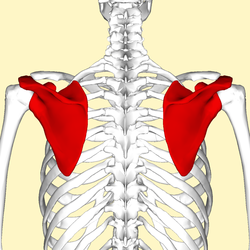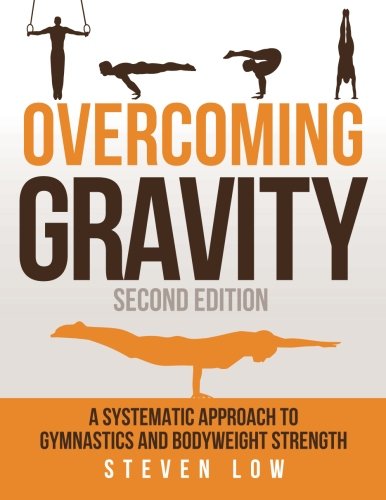I’ve seen numerous comments here and then also questions in http://reddit.com/r/overcominggravity over the years about scapular positioning during bodyweight exercises. Scapular positioning is a bit different from barbell work in quite a few cases. For example, there’s a difference between pushups and bench press:
- Bench press — you start with depressed and retracted the scapulas, and you keep them in that position during the entire exercise.
- Pushups — you start with protracted and depressed scapulas, and you move them through to a retracted and depressed position at the bottom of the movement. You move back through from the retracted and depressed position to protracted and depressed at the top of the movement.
The main issues that I’ve seen is recommending protracted and retracted when the scapulas should simply be held in neutral position. There is a difference between cuing for the correct scapular position and the actual correct scapular position. Let me give you some examples from a post I received that will help you understand this.
L-sit (I try to keep it retracted and downwards but actually I can’t, so just for now I keep it protracted as down as I can)
The scapulas should be depressed and neutral during the L-sit. However the tendency is to protract during L-sits so you should focus on depressing and retracting to get it to neutral. This is the same as parallette and rings support holds especially with RTO.
The reason for the neutral scapular position is that ideally you want a perfectly straight torso or body. Protracted scapulas almost inevitably round the upper back and and retracted scapulas tend to strongly arch the back. Both things you want to avoid during straight body movements. Additionally, the neutral scapular position is the strongest position for the scapulas as the muscles are closest to their resting length which means if your muscles are not imbalanced you have optimal scapular stability in that position for straight body movements.
Back Lever (I’m doing the tuck; but I think it is ideal to keep it retracted)
The back lever should have depressed and neutral (neither protracted or retracted) scapular positioning. It should come as no surprise here that you want neutral scapulas during the back lever. However, they may naturally want to retract due to the pull of gravity on the body, so you might have to focus on a bit of protracting to keep them neutral.
Sometimes you see that people will round the chest and over-protract the scapulas which makes their body into a rounded C hollow shape, and sometimes you will see that people over-retract and arch the body which means they have a rounded C arch shape. Both of these are incorrect.
Rows (in theory should be a mobility ex, so all protracted to the bottom, all retracted at the top)
Correct. Protracted and depressed at bottom and retracted and depressed at the top.
Front Lever (retracted and downwards)
In the front lever, the scapulas should be depressed and neutral but the tendency is to to protract so it will feel like you need to retract and depress strongly.
Pull-ups (Retracted and downwards?)
Pullups will require the scapulas to be depressed and maybe slightly retracted. Regarding retraction will hinder the upward and downward rotation of the scapula during the movement which is needed. Retraction is more of a cue to stabilize the scapula that may give a bit of extra tension because moving out of the bottom is difficult for beginners. You should mainly focus on depression.
Push-ups (diamond, Retracted and downwards?)
The reverse of rows. Protracted and depressed at the top and it moves through to retracted and depressed at the bottom. Reverse going back up.
- Cuing — What you need to do with your scapulas to get them into the right position.
- Technique — the actual position of the scapulas during the movement.
- Technique and cuing aim for the same goal, but they might use different wording which may be confusing.
Also, some other comments and general conclusions:
- Generally, the only time the scapulas elevate is in upward vertical pressing like handstands, handstand pushups, etc.
- In bodyweight movements the scapulas will move during the movement. Generally from one extreme range to the other.
- In bodyweight isometrics the scapulas will usually stay neutral and elevated or depressed, but you may have to protract or retract depending on the tendency of the scapulas to move in one direction. This is very similar to fighting to turn the rings out during support holds.
This should give you a better idea of the difference between correct scapular positioning versus the cuing that is typically discussed during these movements.
Overall, there’s really no one set rule. Generally speaking, there are certain trends. Usually the scapulas will stabilize the glenohumeral joint which means that they’re often going to be pulling or pushing against gravity. This means that they will usually be working hard in the position and not relaxing. However, this can vary depending on the exercise.
This is one of the reasons that I wrote about scapular positioning extensively for all of the exercises in Overcoming Gravity 2nd Edition. The First Edition did not have the scapular positioning in it, and there were many different questions that came up about it. I tried to answer as many questions about them in this post, which should give you a solid idea of how the mechanics for the scapulas work for bodyweight training. However, if you have any further questions, feel free to ask me on reddit or check out the book for details scapular positioning and many other facets of training.
Information adapted from this reddit post, updated with new information. Photo from wikipedia.org.
Author: Steven Low
Steven Low is the author of Overcoming Gravity: A Systematic Approach to Gymnastics and Bodyweight Strength (Second Edition), Overcoming Poor Posture, Overcoming Tendonitis, and Overcoming Gravity Advanced Programming. He is a former gymnast who has performed with and coached the exhibitional gymnastics troupe, Gymkana. Steven has a Bachelor of Science in Biochemistry from the University of Maryland College Park, and his Doctorate of Physical Therapy from the University of Maryland Baltimore. Steven is a Senior trainer for Dragon Door’s Progressive Calisthenics Certification (PCC). He has also spent thousands of hours independently researching the scientific foundations of health, fitness and nutrition and is able to provide many insights into practical care for injuries. His training is varied and intense with a focus on gymnastics, parkour, rock climbing, and sprinting. Digital copies of the books are available in the store.

